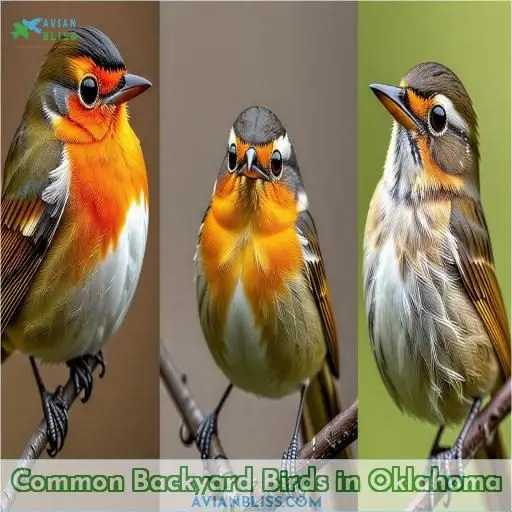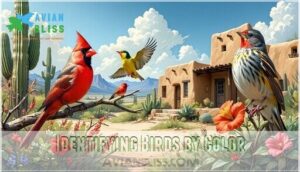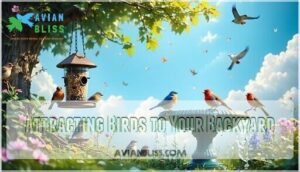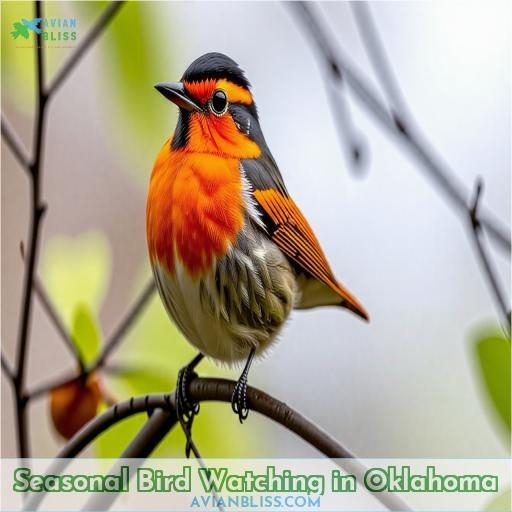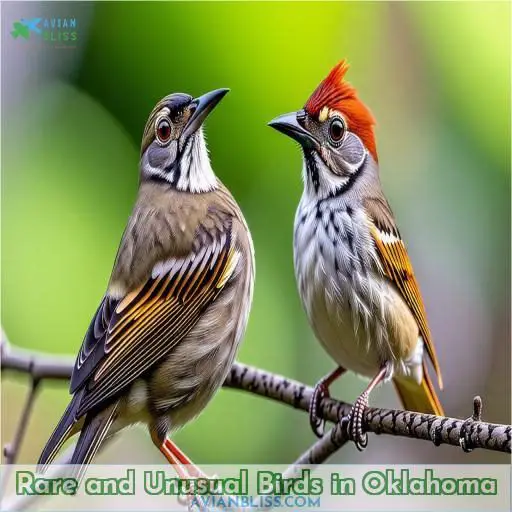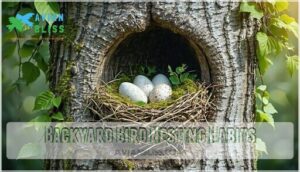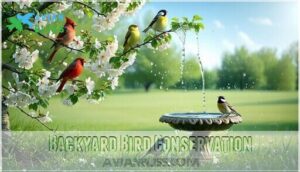This site is supported by our readers. We may earn a commission, at no cost to you, if you purchase through links.
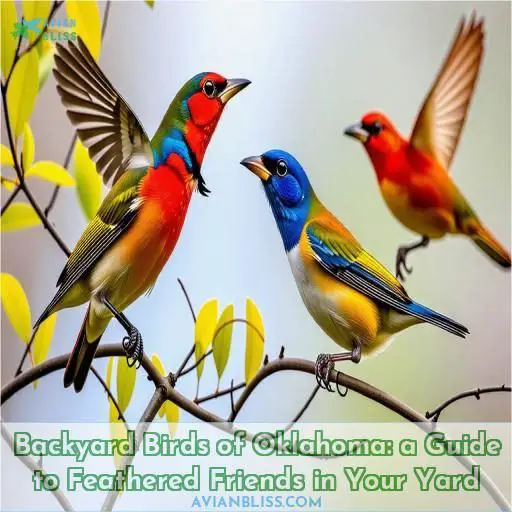
The vibrant Northern Cardinal, graceful Mourning Dove, and boisterous Red-winged Blackbird are common sights.
But there’s more! Learn to identify birds by color, from bright yellow American Goldfinches to rich blue Eastern Bluebirds.
Attract feathered friends with feeders, birdbaths, and native plants.
Enjoy seasonal bird-watching as hawks migrate in spring or cranes overwinter.
By understanding their habits and implementing conservation strategies, you’ll create a welcoming haven for Oklahoma’s backyard birds.
And that’s just the beginning – the experiences these winged wonders offer are truly engaging.
Table Of Contents
- Key Takeaways
- Common Backyard Birds in Oklahoma
- Identifying Birds by Color
- Attracting Birds to Your Backyard
- Seasonal Bird Watching in Oklahoma
- Rare and Unusual Birds in Oklahoma
- Backyard Bird Feeding Tips
- Backyard Bird Nesting Habits
- Backyard Bird Behavior
- Backyard Bird Conservation
- Frequently Asked Questions (FAQs)
- How do I identify a bird in my backyard?
- What is the most common bird in Oklahoma?
- How do I know what birds are in my area?
- What kind of bird has a yellow belly in Oklahoma?
- How do I report a banded bird I found?
- What should I do about a bird attacking my window?
- Are pepper-based squirrel deterrents safe for birds?
- When is it safe to remove nests around buildings?
- What causes deformed beaks in birds?
- Conclusion
Key Takeaways
- Enjoy a diverse array of Oklahoma backyard birds like the vibrant Northern Cardinal, graceful Mourning Dove, and boisterous Red-winged Blackbird.
- Identify birds by color, from bright yellow American Goldfinches to rich blue Eastern Bluebirds, enhancing your bird-watching experience.
- Attract feathered friends with feeders, birdbaths, and native plants to create a welcoming haven for Oklahoma’s backyard birds.
- Implement conservation strategies to protect backyard birds from threats like habitat loss, window collisions, outdoor cats, pesticides, and climate change.
Common Backyard Birds in Oklahoma
You’ll commonly encounter the vibrant Northern Cardinal, graceful Mourning Dove, boisterous Red-winged Blackbird, cheerful American Robin, and ubiquitous House Sparrow in Oklahoma backyards. These species are easily identifiable by their distinct colors, calls, and behaviors, making backyard bird watching an enjoyable and educational pastime.
Northern Cardinal
The Northern Cardinal is a prominent backyard bird in Oklahoma, recognized for its vibrant red plumage and melodious song.
It typically thrives in various habitats, including woodlands, gardens, and urban areas.
Cardinals primarily consume seeds, fruits, and insects. Their conservation is critical due to habitat loss.
Symbolically, the cardinal represents beauty and essentiality.
Observing their interactions with other birds like hawks, sparrows, and woodpeckers is quite fascinating.
Mourning Dove
The Mourning Dove, a common backyard bird in Oklahoma, is often known for its gentle cooing call and distinctive swift flight. They’ve been observed in significant numbers across Oklahoma during colder months. These doves prefer open habitats and are often seen near backyard bird feeders . Below is a table comparing the notable aspects of the Mourning Dove with other backyard birds.
| Traits | Mourning Dove |
|---|---|
| Sightings | Typically sighted in significant numbers |
| Diet | Primarily seeds, with occasional grains and insects |
| Behavior | Ground-feeding, swift flight, gentle cooing calls |
| Nest | Simple, platform-like, made of twigs and grasses |
| Habitat | Open areas, fields, backyard feeders |
Red-winged Blackbird
The Red-winged Blackbird, commonly found in Oklahoma, showcases distinctive red and yellow shoulder patches. Their melodic songs resonate in wetland habitats, where they nest among cattails and shrubs. These agile birds exhibit territorial behavior, especially during the breeding season, and are known for their impressive aerial displays. Understanding their migration patterns can enhance your birdwatching experience.
American Robin
The American Robin, a familiar sight in Oklahoma backyards, is a thrush known for its cheerful song and distinctive orange breast. These adaptable birds thrive in urban and suburban areas, nesting in trees and shrubs. Robins feed on a variety of insects, worms, and berries, making them a welcome addition to any garden.
- Robins are one of the earliest birds to sing at dawn.
- They often forage in groups, especially during migration.
- Robins are known for their distinctive cheerio-cheerio song.
- They’re excellent at locating earthworms by sight and sound.
- Robins are a sign of spring and renewal in many cultures.
House Sparrow
The House Sparrow, a feisty little bird, is a common sight in Oklahoma backyards. These adaptable creatures thrive on human presence, often nesting in eaves and gutters. Their cheerful chirping adds life to any garden. To attract House Sparrows, offer a variety of seeds and suet. With their bold personalities, these birds bring endless entertainment to avid birdwatchers.
| Behavior | Migration |
|---|---|
| Aggressive | Year-round resident |
| Noisy | Rarely migrates |
| Adaptable | Stays close to human habitats |
| Feeding Habits | Conservation |
| —————- | ————– |
| Eats seeds, grains, insects | Considered an invasive species |
| Forages on the ground | Competes with native birds |
| Visits feeders regularly | Adapts well to urban environments |
House Sparrows symbolize resilience, resourcefulness, and the joy of simple pleasures. Their presence reminds us to embrace life’s small wonders and find happiness in unexpected places.
Identifying Birds by Color
You can identify many backyard birds by their color. For example, bright yellow birds like the American Goldfinch or Yellow Warbler, vibrant red birds such as the Northern Cardinal or Summer Tanager, and rich blue birds like the Eastern Bluebird or Indigo Bunting often visit Oklahoma backyards.
Yellow Birds
Yellow birds such as Yellow Warblers and Goldfinches are commonly found in Oklahoma.
The vibrant yellow plumage of these birds makes them easily identifiable.
Their presence adds a lively touch to backyard birdwatching.
Observing their behavior and distinct features can enhance your birding experience, providing a deeper understanding of these delightful Yellow Warblers, Goldfinches, and other yellow-hued avian species in Oklahoma.
Red Birds
When identifying red birds in Oklahoma, look for these distinctive species:
- Northern Cardinal
- Summer Tanager
- Red-headed Woodpecker
- Scarlet Tanager
These species boast vibrant red plumage and can be commonly spotted in Oklahoma’s yards and woodlands. Keep an eye out for these iconic red birds as you enjoy the diverse avian life in your surroundings.
Blue Birds
Blue birds like the Eastern Bluebird are a joy to spot in Oklahoma backyards. Look for their bright blue backs, white bellies, and rusty chests. Bluebirds prefer open habitats with scattered trees and nest in cavities, so provide a bluebird house. They eat insects and berries. Listen for their cheerful warble. Bluebirds are year-round residents in Oklahoma.
Black Birds
Black birds are easy to spot in your Oklahoma backyard! Look for:
- Red-winged Blackbirds with their bold red shoulder patches and buzzy songs
- Grackles with iridescent feathers and long tails, often seen in large flocks
- Cowbirds, nest parasites that lay eggs in other birds’ nests
- Bobolinks in breeding plumage, with black bodies and white patches
- Brown-headed Cowbirds, another nest parasite species
To attract blackbirds, offer millet and sunflower seeds. Provide water and native plants for nesting. Protect blackbirds by keeping cats indoors and reducing pesticide use. Enjoy these charismatic backyard birds!
Brown Birds
Brown birds are a diverse group found in Oklahoma backyards. From the rusty-colored House Sparrow to the streaked Lark Bunting, these feathered friends add beauty and interest. Observe their unique behaviors, like the Mourning Dove’s gentle cooing or the Killdeer’s broken-wing act. Protect brown birds by providing native plants and avoiding pesticides. With a keen eye, you’ll appreciate the subtle charm of these backyard beauties.
| Species | Identifying Features | Habitat |
|---|---|---|
| House Sparrow | Small, brown with black bib | Urban areas, parks |
| Lark Bunting | Black in summer, brown in winter | Grasslands, fields |
| Mourning Dove | Long tapered tail, round head | Open areas, feeders |
Attracting Birds to Your Backyard
You can attract a variety of birds to your backyard by providing essential resources such as:
Feeders filled with high-quality seed
Birdbaths for drinking and bathing
Native plants that offer food and shelter
Nesting boxes designed for specific species
Reliable water sources like small ponds or misters
Properly maintaining these elements and considering the specific needs of your local bird population will create an inviting environment for feathered visitors throughout the year.
Feeders
Avoid discussing things which would be discussed in the NEXT SUBTOPIC entitled ‘Native Plants‘.
Birdbaths
When setting up birdbaths, consider placing them in open areas.
Using various depths to accommodate different bird species.
Aim for water depths of 1-3 inches to attract egrets, grebes, plovers, kingbirds, and swallows.
Ensure birdbath accessories, like water drippers or fountains, help maintain water quality.
Clean birdbaths regularly to prevent the spread of diseases and provide a healthy environment for visiting birds.
Native Plants
Attract birds to your Oklahoma backyard by planting native plants from local nurseries. Choose pollinator plants and drought-tolerant species for bird-friendly landscaping. Consider species like wood-pewee, titmouse, gnatcatcher, phoebe, and kinglet when selecting your plants to create a welcoming environment for birds. Native plants guarantee the best chances of thriving in your garden and supporting the local ecosystem .
Nesting Boxes
Nesting boxes provide safe havens for birds like flycatchers, owls, and woodpeckers. Choose the right size and placement, using untreated wood and ventilation holes. Fill with soft nesting materials like grass, moss, or feathers. Clean boxes annually and monitor for occupancy. Enjoy watching birds raise their young in your backyard oasis!
Water Sources
Providing a dependable source of clean water is essential for luring birds to your backyard. Install a birdbath or shallow dish, maintain its cleanliness, and consider adding a dripper or mister to attract birds. Verify that the water is shallow, less than 2 inches deep, and position the bath near shrubs for protection from predators .
- Provide a dependable source of clean, unfrozen water year-round
- Keep birdbaths clean and free of algae and debris
- Place baths near cover but away from feeders to prevent contamination
Seasonal Bird Watching in Oklahoma
With the changing seasons, your backyard bird watching opportunities evolve as migratory species arrive or depart while year-round residents remain.
Spring migration brings a wave of colorful warblers, tanagers, and grosbeaks passing through Oklahoma, pausing to refuel before continuing their journey northward.
Summer finds resident species like Northern Cardinals, Mourning Doves, and Red-winged Blackbirds nesting and rearing their young in local habitats.
Spring Migration
Spring migration in Oklahoma brings the arrival of various bird species drawn by favorable weather patterns and habitat changes. Notable migrants include hawks, geese, kites, rails, and whistling-ducks. Tracking bird arrival during this time provides insights into migration patterns and nesting success. Understanding the influences of weather patterns on migratory behavior is important for birdwatchers and conservation efforts.
Summer Breeding
During the summer breeding season in Oklahoma, observe songbird courtship displays, nestling development, and fledgling behaviors. Breeding season length varies, with egg incubation durations specific to each species like the red-tailed hawk, hairy woodpecker, killdeer, cuckoo, and roadrunner. Engage in the fascinating spectacle of avian life cycles as these birds diligently raise their young in your backyard sanctuary.
Fall Migration
As fall approaches, Oklahoma’s skies come alive with the spectacle of bird migration.
Flocks of nighthawks, harriers, and parulas wing their way south, while teals and waxwings join the journey.
Bird banding stations track their progress, revealing the intricate patterns of their migratory routes and the importance of stopover sites along the way.
Observe these avian travelers as they pause to refuel and rest before continuing their journey.
Winter Residents
As the leaves fall and temperatures drop, Oklahoma’s backyards welcome a new cast of feathered friends.
Bitterns, cranes, eagles, hawks, and owls arrive from the north, seeking food and shelter.
Adapt your feeders with high-energy suet and seed mixes to support these winter residents.
Grab your binoculars and discover the unique adaptations that allow these birds to thrive in the cold.
Year-Round Species
Some backyard birds in Oklahoma, like the Northern Cardinal and Carolina Chickadee, are year-round residents. To attract these feathered friends year-round:
- Provide a variety of feeders with different seed types, suet, and mealworms.
- Install a heated birdbath for drinking and bathing.
- Plant native trees, shrubs, and flowers that offer food and shelter.
Rare and Unusual Birds in Oklahoma
While most backyard birds in Oklahoma are common species like cardinals, robins, and sparrows, you may occasionally spot a few rare and unusual visitors. Keep an eye out for the reddish egret, roseate spoonbill, painted bunting, varied bunting, and groove-billed ani – their striking plumage and behaviors make them a memorable sight in your yard.
Reddish Egret
The Reddish Egret, a stunning bird native to Oklahoma, exhibits unique habitat preferences favoring shallow coastal waters.
Its diet mainly comprises fish, crustaceans, and amphibians.
Classified as Near Threatened due to habitat degradation, conservation efforts focus on preserving coastal wetlands.
During breeding, they exhibit elaborate courtship displays.
Their migration patterns vary, with some individuals migrating locally, unlike storks or falcons, emphasizing their distinct behavior among bird species.
Roseate Spoonbill
The Roseate Spoonbill is a stunning wading bird with a unique spoon-shaped bill.
These rare visitors to Oklahoma prefer coastal habitats, but occasionally venture inland.
They nest in colonies with other wading birds, feeding on small fish, crustaceans, and aquatic insects.
Habitat loss and human disturbance threaten this beautiful species.
Keep an eye out for these pink beauties near wetlands and estuaries.
Painted Bunting
The stunning Painted Bunting is a rare visitor to Oklahoma backyards. These colorful birds breed in the south-central U.S. and winter in Mexico and Central America. Look for them in brushy areas, thickets, and along forest edges. They eat seeds, berries, and insects. Conserve habitat to protect this beautiful species. (Source)
Varied Bunting
The varied bunting is a rare sight in Oklahoma backyards. This colorful bird prefers dense, brushy habitats along the state’s southern border. Its diet consists mainly of seeds and insects. Varied buntings migrate to Mexico and Central America for the winter. Though uncommon, these vibrant birds are a treat for any Oklahoma birder to spot.
Groove-billed Ani
The Groove-billed Ani is a rare and unusual bird in Oklahoma, identified by its unique vocalizations, intricate mating behavior, and nesting habits.
This bird has a diverse diet and distinct migration patterns, making it a fascinating subject for birdwatchers.
Photos and information about the Groove-billed Ani can be shared on birding forums or listservs, contributing to the collective understanding of this remarkable species .
Backyard Bird Feeding Tips
To attract a wide variety of backyard birds, offer an assortment of seed types, including black oil sunflower, nyjer, safflower, and mixed seed.
Suet cakes and hummingbird nectar are also excellent options for providing energy-rich sustenance to your feathered visitors.
When placing feeders, choose locations that offer nearby cover from predators and inclement weather but remain visible from a comfortable viewing area.
Proper feeder maintenance, such as regular cleaning and seed replenishment, guarantees a hospitable environment for your backyard bird population.
Seed Types
When stocking up on seed for your backyard birds, look for high-quality mixes that include a variety of seeds like black oil sunflower, nyjer, millet, and safflower.
Store seed in airtight containers in a cool, dry place to maintain freshness.
Offer multiple seed types in separate feeders to attract a wider range of species.
A little goes a long way – fill feeders just enough to last a few days to prevent spoilage.
Suet
When selecting suet for birds in Oklahoma, it’s important to contemplate various types, such as traditional, no-melt, or specialty blends with added fruits or insects.
Place suet feeders in shaded areas to prevent melting in warmer weather and offer birds a high-energy food source in winter.
Suet provides essential fats and proteins, benefiting birds year-round.
Consider making homemade suet or explore different commercial recipes for variety.
Hummingbird Nectar
Hummingbirds are drawn to nectar feeders, making it important to know the proper nectar recipe. A mixture of 4 parts water to 1 part sugar is recommended, ensuring a sufficient sugar concentration. Opt for feeder types with bright colors to attract hummingbirds. Regular nectar maintenance, including cleaning and refilling, is essential for the well-being of these remarkable birds. (Source)
Feeder Placement
When determining where to place your bird feeder, consider the feeder types and bird preferences.
Suitable locations include areas with open spaces for easy predator avoidance.
Make sure windows are a safe proximity away to prevent bird collisions.
Place the feeder near trees or shrubs to provide cover for birds.
Take care to position it in a spot that allows for easy observation from your home.
Feeder Maintenance
To keep your feeder birds healthy, clean feeders every 2-3 weeks with a 10% bleach solution. Dry thoroughly before refilling. Discard moldy seed. Feeders with drainage holes and perches that allow waste to fall through are best. Proper feeder hygiene prevents disease transmission and guarantees your backyard birds stay happy and healthy all year round.
Backyard Bird Nesting Habits
You’re in for an enthralling experience observing the nesting habits of backyard birds in Oklahoma. From nest construction using twigs, grass, and other materials, to egg laying, incubation periods, caring for nestlings, and witnessing fledglings take their first flight, the nesting cycle offers an insightful glimpse into avian life.
Nest Building
As spring arrives in Oklahoma, backyard birds get busy constructing their nests. They gather twigs, grass, moss, and even human hair to weave intricate homes. Cardinals prefer dense shrubs, while bluebirds look for nest boxes or tree cavities. Robins build mud-and-grass cups on ledges. Doves make flimsy stick platforms. Beware of nest predators like cats, snakes, and squirrels.
Egg Laying
During egg laying, female backyard birds select a suitable nesting site and use an array of nesting materials to construct a secure nest. The process of egg development takes place over a specific incubation period, essential for fledgling success. The selection of an appropriate nest site plays a pivotal role in ensuring the safety and well-being of the incubating eggs.
Incubation
Once the eggs are laid, birds must keep them warm for a specific period to guarantee healthy development of the chicks.
This incubation period varies by species, but parents take turns sitting on the nest, using their body heat to maintain the ideal temperature.
Eggs typically hatch after 12-15 days for songbirds.
Brood parasites like cowbirds lay their eggs in other birds’ nests, relying on the host parents to incubate and raise their young.
Nestling Care
Once the eggs hatch, both parents work tirelessly to feed the hungry nestlings. They bring a variety of insects, spiders, seeds and berries to the nest. Nestlings are vulnerable to predators like snakes, cats and raccoons. Parasites like mites and blowfly larvae can also harm nestlings. Sadly, many nestlings don’t survive due to lack of food, disease or predation.
Fledgling Behavior
Once nestlings leave the nest, they enter the fledgling stage. Fledglings are still dependent on their parents for food and protection. They’ve limited mobility and rely on begging vocalizations to signal hunger. Parents continue to feed and guard fledglings, gradually encouraging independence. Fledglings eat a diet of insects, seeds, and berries provided by their parents.
- Fledglings beg for food with loud calls
- Parents bring fledglings insects, seeds, and berries
- Fledglings have short flights and hop on branches
- Parents defend fledglings from predators
- Fledglings gradually learn to feed themselves
Backyard Bird Behavior
You’ll often witness fascinating backyard bird behaviors like territorial disputes, where birds aggressively defend their nesting areas or food sources. Courtship displays, such as singing, dancing, or presenting nesting materials, can be observed during breeding seasons as birds attract mates.
Territorial Disputes
As spring arrives, your backyard birds engage in lively territorial disputes. Males belt out loud, complex songs to mark their boundaries and defend their nests from rivals. Feisty females join the fray, chasing away intruders with fierce dives and angry chatter. Food competition intensifies at crowded feeders, with dominant species bullying weaker ones. Resolving these conflicts is key to successful breeding.
| Territorial Songs | Nest Defense | Boundary Disputes | Mating Displays |
|---|---|---|---|
| Loud, complex | Fierce dives | Marking borders | Bright colors |
| Advertise domain | Angry chatter | Rival eviction | Unique plumage |
| Attract mates | Protect eggs | Claim resources | Elaborate songs |
| Warn competitors | Feed young | Maintain territory | Courtship rituals |
Courtship Displays
During spring, male backyard birds put on dazzling courtship displays to attract mates. You may witness:
- Vibrant plumage – males flaunt their brightest feathers.
- Aerial acrobatics – soaring, diving, and fluttering flights.
- Vocal serenades – melodious songs and calls.
- Ritualized dances – strutting, bowing, and wing-flapping.
These behaviors showcase a male’s fitness, territory, and parenting abilities. Observing courtship is a delightful way to appreciate the beauty and complexity of backyard bird life.
Feeding Habits
Bird feeding habits vary widely among species, with different food preferences affecting their behavior in the backyard. Understanding their seed, suet, and nectar preferences is key to attracting a diverse range of birds. Proper feeder placement can also influence the types of birds visiting your yard. A chart comparing the feeding habits of common backyard bird species is provided below:
| Species | Food Preferences |
|---|---|
| Northern Cardinal | Seeds, fruits, insects |
| Mourning Dove | Seeds, grains, insects |
| Red-winged Blackbird | Seeds, grains, insects |
| American Robin | Earthworms, fruits, insects |
| House Sparrow | Seeds, grains, insects |
Bathing and Preening
Birds maintain their feather quality by engaging in bathing and preening behaviors. They use various water sources, such as birdbaths or shallow dishes, for bathing purposes. Seasonal bathing helps them keep their feathers clean and free of debris. After bathing, birds engage in preening, carefully arranging their feathers with their beaks to remove dirt and excess oil. Wet feathers are then air-dried for maximum insulation and waterproofing.
- Utilize various water sources for bathing
- Engage in seasonal bathing to maintain feather quality
- Perform preening behaviors to arrange feathers and remove dirt and oil
- Air-dry wet feathers for insulation and waterproofing
Roosting
As the sun sets, your backyard birds settle in for the night. Many species, like bluebirds and woodpeckers, roost in tree cavities or birdhouses . Others, such as sparrows and finches, prefer dense shrubs or evergreens . Crows and blackbirds often gather in large communal roosts . Observe your feathered friends’ nocturnal behaviors and provide suitable roosting sites to support their needs.
| Roosting Behavior | Examples |
|---|---|
| Tree Cavities | Bluebirds, Woodpeckers |
| Birdhouses | Bluebirds, Wrens |
| Dense Shrubs | Sparrows, Finches |
| Evergreens | Sparrows, Finches |
| Communal Roosts | Crows, Blackbirds |
Backyard Bird Conservation
While observing the delightful feathered visitors in your Oklahoma backyard, it’s vital to be aware of the threats they face, such as habitat loss, window collisions, outdoor cats, pesticide exposure, and climate change’s impacts.
Taking proactive measures to mitigate these risks can contribute to the preservation of these remarkable avian species and ensure their continued presence for generations to come.
Habitat Loss
Habitat loss is the primary threat to backyard birds in Oklahoma. Preserving natural habitats by planting native vegetation and avoiding pesticides is essential. Provide bird-friendly landscaping with dense shrubs, trees, and water sources. Avoid clearing vegetation during nesting season. Outdoor cats also pose a significant threat to backyard birds. Keep cats indoors or use cat enclosures to protect birds.
Window Collisions
Window collisions are a major threat to backyard birds. To keep your feathered friends safe, minimize glass reflections, turn off outdoor lighting at night, and avoid planting vegetation too close to windows. Install window decals or screens to break up reflections and alert birds to the glass barrier. Prioritize bird safety when designing your backyard oasis.
Outdoor Cats
Outdoor cats pose significant dangers to bird populations.
Implementing effective outdoor cat control strategies such as containment, deterrents, and sterilization can help mitigate their impact on bird conservation.
Always consider outdoor cat alternatives that prioritize bird safety and well-being in your backyard habitat.
Pesticides
Pesticides can be harmful to backyard birds. Instead, use organic gardening methods and bird-safe plants to create a healthy habitat. Avoid spraying insecticides, which can poison birds and reduce their food supply. Plant native flowers, shrubs and trees to attract insects for birds to eat. Your backyard can be a safe haven for feathered friends with a few simple changes.
Climate Change
Climate change impacts backyard bird conservation in Oklahoma through range shifts, affecting food availability and increasing habitat loss. To address this, important conservation measures are essential, such as preserving native habitats, reducing pesticide use, and supporting initiatives to mitigate climate change effects. Engaging in habitat restoration projects and promoting awareness about the significance of conserving bird habitats are critical steps in safeguarding backyard bird populations.
- Preserve native habitats
- Reduce pesticide use
- Support climate change mitigation initiatives
- Promote awareness on habitat conservation (Source)
Frequently Asked Questions (FAQs)
How do I identify a bird in my backyard?
Did you know 11,438 American Robins were sighted in Oklahoma last November? To identify backyard birds, use a field guide, note distinguishing features like color, size, and behavior. Getting close-up photos also helps.
What is the most common bird in Oklahoma?
According to the latest FeederWatch data, the American Robin is Oklahoma’s most commonly seen backyard bird. However, regional variations exist, so keep exploring your local area for a thorough picture.
How do I know what birds are in my area?
Joining local birding groups or using apps like Merlin Bird ID, you begin a quest to identify the feathered residents of your area, uncovering nature’s secrets.
What kind of bird has a yellow belly in Oklahoma?
Several birds have yellow bellies in Oklahoma. The most common is the Yellow-bellied Sapsucker, but you might also spot a Yellow Warbler or an American Goldfinch.
How do I report a banded bird I found?
Report banded birds to the nearest wildlife agency. They’ll collect data like the band numbers, colors, location, and condition. This helps track migration patterns and monitor bird populations.
What should I do about a bird attacking my window?
You’ll want to deter the bird humanely. Try covering windows temporarily with paper or soap. Install hawk silhouettes or other predator deterrents near windows. If persists, contact wildlife experts for guidance.
Are pepper-based squirrel deterrents safe for birds?
Pepper-based squirrel deterrents may irritate birds’ eyes and respiratory systems. A bird’s eyes are sensitive, like rubbing pepper in your own – it’s a stinging, blinding experience best avoided through natural deterrents or physical barriers.
When is it safe to remove nests around buildings?
You should remove nests around buildings only after young birds have fledged and left the nest. To avoid disturbing active nests, it’s best to wait until late summer or early fall before nest removal.
What causes deformed beaks in birds?
You may observe deformed beaks in birds due to exposure to certain environmental contaminants or genetic defects during development.
Conclusion
Like an avian symphony, the backyard birds of Oklahoma offer an enchanting performance.
By embracing their vibrant plumage, distinct behaviors, and ecological roles, you’ll discover a world of fascination right in your yard.
Implement sustainable practices, nurture their habitats, and join the chorus of bird enthusiasts celebrating these feathered wonders.
Every flutter and song celebrate nature’s resilience—a treasure to cherish for generations.

